Baltimore Police Department
| Baltimore Police Department | |
|---|---|
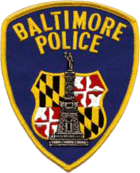 Patch of the Baltimore Police Department | |
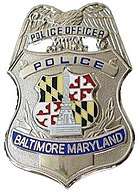 Badge of the Baltimore Police Department | |
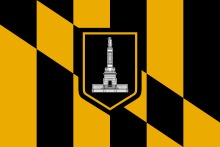 Flag of the City of Baltimore | |
| Common name | Baltimore Police Department |
| Abbreviation | BPD |
| Motto |
Semper Paratus, Semper Fideles, Ever on the Watch Ever Ready, Ever Faithful, Ever on the Watch |
| Agency overview | |
| Formed | 1845 |
| Employees | 3,220 (2013)[1] |
| Jurisdictional structure | |
| Operations jurisdiction | Baltimore, Maryland, United States |
 | |
| Baltimore Police Districts | |
| Size | 148.14 km² |
| Population | 621,342 |
| Legal jurisdiction | Baltimore, Maryland |
| General nature | • Local civilian agency |
| Headquarters |
Bishop L. Robinson, Sr. Police Administration Building 601 E Fayette St Baltimore, Maryland 21202 |
|
| |
| Officers | 3,080 (2014)[2] |
| Mayor of Baltimore responsible | |
| Agency executives |
|
| Parent agency | Baltimore City Council |
| Facilities | |
| Districts |
1-Central 2-Southeast 3-Eastern 4-Northeast 5-Northern 6-Northwest 7-Western 8-Southwest 9-Southern |
| Marked and Unmarked Vehicles | Chevrolet Suburbans, Tahoes, Caprices, Ford Taurus Interceptors, Utility Interceptors, Explorers, Escapes and Harley-Davidson Police Motorcycles |
| Helicopters | Eurocopter EC 120 |
| Horses | 12 |
| Website | |
| Baltimore Police Website | |
The Baltimore Police Department (BPD) provides police services to the city of Baltimore, Maryland. It is the eighth-largest police force in the United States and is organized into ten districts; nine geographical and the Public Housing Section. It polices 80.9 square miles (210 km2) of land and 11.1 square miles (29 km2) of waterways. The department is sometimes referred to as the Baltimore City Police Department to distinguish it from the Baltimore County Police Department.
In April 2017, U.S. District Judge James K. Bredar approved a proposed consent decree between Baltimore and the U.S. Department of Justice, "mandating sweeping police reforms at a time of intense violence and deep community distrust in the city police."[3] He denied a Department of Justice request to postpone signing the decree for 30 days in order to allow review by the Trump Administration.[3][4]
On May 10, 2018, newly appointed Police Commissioner Darryl De Sousa was charged in U.S. District Court with three misdemeanor counts of failing to file federal taxes for 2013, 2014 and 2015.[5] Mayor Catherine Pugh initially expressed support for De Sousa, but a day later she suspended him with pay pending the resolution of the charges against him.[6] De Sousa resigned several days later.[7]
History
Foundation to the 1930s
The first attempt to establish professional policing in Baltimore was in 1784, nearly 60 years after the founding of the colonial town and eight years after United States independence. The city authorized a night watch and a force of day constables to enforce town laws. Nightwatchman George Workner was the first law enforcement officer to be killed in the city; he was stabbed during an escape attempt by nine inmates at Baltimore City Jail on March 14, 1808.[8]
The Department was founded in its current form (with uniforms and firearms) in 1853 by the Maryland state legislature "to provide for a better security for life and property in the City of Baltimore". The state did not give the city the power to run its own police affairs. The early decades of the Department were marked by internal political conflict over split loyalties. In 1857 the police were reorganized by Mayor Thomas Swann and new men were recruited; many came from Know Nothing gangs in the city and maintained loyalties to former leaders.[9] The first BPD officer to die in the line of duty was Sergeant William Jourdan, who was shot and killed by an unknown gunman during the first city council elections on October 14, 1857.[10][11]
In 1861, during the U.S. Civil War, the police department was taken over by the federal government after police helped push Union and Confederate rioters into a full-out armed confrontation in the Baltimore riot of 1861. The U.S. Military ran the police department until 1862, when they turned authority back to the state legislature.
The department introduced call boxes in 1885, the Bertillion identification system in 1896, and radio communications in 1933.
The 1930s to the Civil Rights era
The first African American officer hired by the department was a woman: Violet Hill Whyte, in 1937.[12] The first black male officers (Walter T. Eubanks Jr., Harry S. Scott, Milton Gardner, and J. Hiram Butler Jr.) were hired the year after. They were all assigned to plainclothes duty to work undercover.[13] In 1943, African Americans were allowed to wear police uniforms, and by 1950 there were 50 black officers in the department.[13]
African American officers at this point were barred from using squad cars, hit a ceiling in promotion and were limited to patrolling black neighbourhoods or assignments in the Narcotics Division or as undercover officers.[14] They were subjected to racial harassment from both white coworkers (including the use of racial slurs during roll call[15]) and African American residents (including degrading racial graffiti). Bishop L. Robinson and Edward J. Tilghman were two black police officers during this period; both later served as police commissioner.[14] Local Republican politician Marse Callaway played a significant role in increasing the number of African American officers.In 1962, Patrolman Henry Smith Jr. was the first African American officer to die in the line of duty; he was shot breaking up a dice game on North Milton Avenue.[16]

As with other American cities post-World War II suburbanization, encouraged by government programs, drew large numbers of white residents out of the city. There had always been a large African American minority in Baltimore, which had been growing steadily and became a majority in the mid 20th century. The police department remained dominated by whites; traditionally mostly Irish Americans.[17]
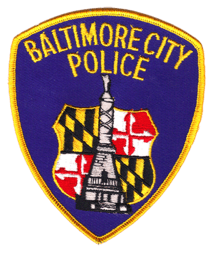
During the Civil Rights Movement, trust between the department and the predominantly black city became increasingly strained, as African Americans pressed for fair treatment and social justice. In the 1960s, race riots erupted in Baltimore and other cities. Some positive change was implemented under Commissioner Donald Pomerleau, appointed in 1966 after consulting for the International Association of Chiefs of Police in the city for two years and writing a damning report on the department.[18] Pomerleau described the BPD as "the most corrupt and antiquated in the nation, and had developed almost no positive relationship with the city's Negro community",[19] Pomerleau oversaw many reforms, including the racial integration of the department by 1966, also partly a result of the Civil Rights Act of 1964 and efforts by local black activists.[14] However, racial rioting broke out in 1968 across the city's black neighborhoods in response to the assassination of Martin Luther King Jr. As few black officers yet held rank within the department,[20] the white-dominated department seemed to confront the African American community.
Late 20th Century to present
In the latter part of the 20th century, restructuring of industry and railroads resulted in a massive loss of industrial jobs in Baltimore. These changes resulted in depopulation, unemployment and poverty; all serious challenges for the police department.
Police community relations were severely strained in Baltimore during the "war on drugs", as with other cities, adding to the stresses of several African American neighborhoods in East and West Baltimore already hollowed out by drug use. African American police officers were intensely disliked, as were white ones.[21]
In 1971, African American officers founded the Vanguard Justice Society, to represent their rights and interests.[22] Throughout the 1970s, more African Americans advanced in the department;[22][23][24][25] Black officers were promoted to positions of district commanders and chief of patrol.
In July 1974, officers joined other striking municipal workers for five days during the Baltimore police strike.
In 1984, Mayor Donald Schaefer appointed to veteran police officer Bishop L. Robinson as Baltimore's first black police commissioner.[26] The department had previously long been dominated by ethnic Irish American and briefly by Italian Americans.[27][28] Robinson had been the force's first Black officer to command the Eastern District and the Patrol Division. The department redefined several of its policies in effort to avoid the mistakes other departments made in the Watts riots of Los Angeles and Liberty City Riots in Miami.
The department began using computerized booking procedures and 911 emergency systems in 1985, and created the first ever 311 non-emergency system in 1996. CCTV cameras began to be used in the same year, while the CitiStat system was introduced in 2000,[29] enabling police to concentrate resources where they would be most needed or effective. During Martin O'Malley's administration as mayor, the department was made up of 43% African American officers.[30]
Following the death of Freddie Gray in police custody in 2015, there was rioting in black neighborhoods. The city invited the Department of Justice to conduct an investigation of the police department and its relations with the community. It found evidence of widespread unconstitutional and discriminatory police practices in the city, especially in poor, black neighborhoods.

Following reporting from the investigation, the city, police department and the Civil Rights Division of DOJ negotiated a consent decree,
including limits on when and how the [police] can engage individuals suspected of criminal activity. It orders more training for police on de-escalation tactics and interactions with youths, those with mental illness and protesters, as well as more supervision for officers.[3]
US District Judge James K. Bredar approved the decree in early April 2017, with commitment from Mayor Catherine Pugh and Police Commissioner Kevin Davis to make the changes proposed. Pugh already had included $10 million in the city budget for this purpose. The city will also be required to invest in better technology and equipment, and "for the Police Department to enhance civilian oversight and transparency."[3]
Mergers
The Department absorbed the City Park Police in the early 1960s. In 2005, the Housing Authority Police were disbanded and operations taken over by the Baltimore Police Department. Housing Authority officers had to reapply for jobs with the city police, losing any previous seniority. In the 2010s, there has been discussion of merging the Baltimore Schools Police into the department as well.[31]
Rank structure and insignia
| Title | Insignia | Uniform shirt color | Badge color |
|---|---|---|---|
| Police Commissioner | White | Gold | |
| Deputy Police Commissioner | White | Gold | |
| Colonel | White | Gold | |
| Lieutenant Colonel | White | Gold | |
| Major | White | Gold | |
| Captain | White | Gold | |
| Lieutenant | White | Gold | |
| Sergeant | Dark Blue | Silver | |
| Police Officer / Detective | Dark Blue | Silver | |
| Police Trainee | Dark Blue w/ khaki pants | None |
Promotion is possible after three years of service. Opportunities for advanced training are provided, including specialized firearms training, defense tactics, and job-related topics such as basic criminal investigation.[32] Hash marks, one for every five years service, will be worn on the left sleeve of the uniform as of 2015. In July 2016 the ranks of Lieutenant Colonel and Colonel were intended to be eliminated as a streamlining and standardisation measure, with all affected personnel being appointed to the rank of Chief, a title formerly used only by certain civilian employees within the department.[33] However, as of 2018 both Colonel and Lieutenant Colonel ranks are still in use.[34]
Organization[35]
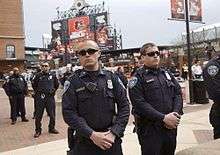
The Baltimore Police Department has more than 3200 sworn and civilian personnel, including dispatchers, crime lab technicians, chaplains, and unarmed auxiliary police officers. Officers are assigned to one of nine districts in the city or a specialized unit. Officers in patrol units work 4 ten-hour shifts a week.
As of 2018, the department is administered by Interim Commissioner Gary Tuggle. The Commissioner is head of the department. Under them are three Deputy Commissioners, heading the Neighborhood Patrol, Investigation and Intelligence, and Professional Standards and Accountability Bureaus. In addition a civilian Chief Financial Officer oversees the Management Services Division.
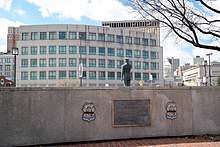
Office of the Police Commissioner
- Chief of Staff
- Media Relations Section
- Governmental Affairs
- Executive Protection Unit
- Legal Affairs Section

Neighborhood Patrol Division
- Chief of Patrol
- Inspector
- Night Commander
- Area I
- Central District
- Headquarters Security Unit
- Southeastern District
- Southern District
- Special Operations Section Unit
- SWAT Platoon A
- SWAT Platoon B
- K-9 Unit
- Traffic Unit
- Aviation Unit
- Stadiums & Honor Guard Unit
- Special Events & Auxiliary Unit
- Emergency Service & Marine Unit
- Central District
- Area II
- Eastern District
- Northeastern District
- Northern District
- Special Enforcement Section Vice Unit
- Area III
- Northwestern District
- Western District
- Southwestern District
- Adult & Juvenile Booking Court Liaison Unit
- Community Relations Division Unit
- Victim Services Unit
- Re-Entry Unit
- Neighborhood Services Liaison Unit
- Inspector
Criminal Investigation Division
- Chief of Detectives
- Homicide Unit
- District Detective Unit
- City Wide Robbery Unit
- Advance Technical Unit
- Witness Services Unit
- Special Investigations Section
- Arson Unit
- State's Attorney's Liaison
- Pawn Shop Unit
- Economic Crimes Unit
- Child Abuse
- Missing Persons
- Domestic Violence
- Sex Offense
- Operational Intelligence Section
- Task Force & HIDTA Teams
- Cyber & Electronic Crimes Unit
- Regional Auto Theft Task Force
- Warrant Apprehension Task Force
- Gun Offender Registry
- Analytical Intelligence Section
- Watch Center
- Crime Analysis
- Citiwatch
- Comstat Unit
- Crime Laboratory Section
Homeland Security Division
- Communications Section
- Information Technology Section
- Records and Research Section
- Citiwatch
- Building Security
Special Operations Division
- Tactical Section
- Strategic Response Section
- Traffic Section
Office of Professional Responsibility
- Anti-Corruption and Ethical Investigations
- Equal Opportunity and Diversity Section
- Internal Affairs Section
Office of Constitutional and Impartial Policing
- Evidence Control Unit
- Best Practices Unit
- Office of Internal Oversight
- General Accountability Office
- Overtime and Secondary Employment Unit
- UCR
- Written Directives Unit
- Education and Training Section
- Police Academy
- Professional Development
- In-Service Training
- Firearm Training Unit
- Armory Unit
- Administrative and Command Investigations Unit
Science and Management Services Division
- Information Technology Section
- Human Resources Section
- Personnel Administration
- Recruitment Unit
- Background Investigation Unit
- Medical Unit
- Light Duty Unit
- Information Services Section
- Communications Unit
- Radio Shop
- Records Management Section
- Mail Room
- Hot Desk & CHASE
- Warrants & Identification
- Criminal History
- Communications Unit
- Fiscal Services
- Property Section
- Facilities Management
- Fleet Management
- Quartermaster Unit
- Finance Section
- Grants Unit
- Property Section
Police Commissioners
- Charles Howard, 1860–63
- Nicholas L.Wood, 1862–64
- Samuel Hindes, 1864–66
- James Young, 1866–67
- LeFevre Jarrett, 1867–70
- John W. Davis, 1870–71
- William H.B. Fusselbaugh, 1871–81
- George Colton, 1881–87
- Edson M. Schryver, 1887–97
- Daniel C. Heddinger, 1897–1900
- George M. Upsher, 1900–04
- George R. Willis, 1904–08
- Sherlock Swann, 1908–10
- John B.A. Wheltle, 1910–12
- Morris A. Soper, 1912–13
- James McEvoy, 1913–14
- Daniel C. Ammidon, 1914–16
- Lawrason Riggs, 1916–20
- Charles D. Gaither, 1920–37 (First Solo Commissioner. Prior to Charles Gaither we had a BOC Board of Commissioners, where we had three or more commissioners on a panel)
- William Lawson, 1937–38
- Robert F. Stanton, 1938–43
- Hamilton R. Atkinson, 1943–49
- Beverly Ober, 1949–55
- James M. Hepbron, 1955–61
- Bernard Schmidt, 1961–66
- Donald D. Pomerleau, 1966–81
- Frank J. Battaglia, 1981–84
- Bishop L. Robinson, 1984–87 (first African American commissioner)[26]
- Edward J. Tilghman, 1987–89
- Edward V. Woods, 1989–93
- Thomas C. Frazier, 1994–99
- Ronald L. Daniel, 2000
- Edward T. Norris, 2000–02
- Kevin P. Clark, 2003–04
- Leonard D. Hamm, 2004–2007
- Frederick H. Bealefeld III, 2007–2012
- Anthony W. Batts, September 2012 – July, 2015
- Kevin Davis, July, 2015 - January 2018
- Darryl D. DeSousa, January 2018 – May 2018
- Gary Tuggle, May 2018 – present
Equipment

Cars and motorcycles
The main squad cars used by the department are the Ford Crown Victoria Police Interceptor and Chevrolet Caprice, along with Harley Davidson motorcycles. Newer versions of the Ford Taurus SHO and Chevrolet Caprice are being implemented. Some older Chevrolet Impalas are still in service. Unmarked Dodge Chargers, Chevrolet Cobalts and Impalas and assorted Kias are used by some command staff and specialized units.
The older vehicle paint scheme was white with blue and silver striping and a replica of an officer's badge on the front doors. A new black paint scheme with blue and yellow stripes is gradually being implemented.
Weapons
The primary service weapon is the Glock 22 .40 caliber pistol, replacing the Glock 17 9mm pistol. Officers are also issued a Monadnock expandable straight baton, Taser X26 and pepper spray. Lethal and less-lethal Remington 870 shotguns are available. The department's SWAT team (originally the Quick Response Team) carried a mix of weapons in its early years, including M16 assault rifles, Colt R0635 sub machine guns and Ruger Mini 14 rifles. In the early 2000s, SWAT rearmed with a standard mix of UMP40 sub machine guns and G36K assault rifles. In 2014, SWAT replaced their assault rifles with the Colt LE6946CQB.
The espantoon is an ornate, straight wooden baton with a long swiveled leather strap designed for twirling. It is distinct to the city of Baltimore and has been in use for generations. Between 1994 and 2000, the espantoon was banned by commissioner Thomas Frazier in favor of the koga stick due to the perception that its twirling intimidated the citizenry. In 2000, Edward T. Norris became commissioner and lifted the ban on the espantoon to raise staff morale and instill a more aggressive approach to policing, although he did not make its use mandatory. Norris stated, "When I found out what they meant to the rank and file, I said, 'Bring them back.' ... It is a tremendous part of the history of this Police Department."[36][37]
Uniform
Sergeants and below wear a navy blue shirt and pants, with a felt stripe down the pant leg, with any rank insignia on the sleeve and collar devices denoting district or unit. Lieutenants and above wear a white shirt with navy blue pants, with rank insignias on the collar. Nametags are worn above the right breast pocket, and sleeve patches are worn on both arms.. Ties are worn with the long sleeve uniform shirt. Turtlenecks with BPD embroidered in gold letters at the collar may be worn with the long sleeve uniform in lieu of a tie. Short sleeve uniform shirts are authorized for warmer months.
The 8 point peaked cap is worn by all officers. Its cap device is the Maryland Coat of Arms; silver for those below the rank of Lieutenant, gold for Lieutenants, and gold with coloured detail for Captains and above. The hat has a chin strap; black for Police Officers and Detectives, blue for Sergeants and gold for Lieutenants and above. Captains and above have gold fretting on their visor. Police Officers have their badge number below the coat of arms, while Detectives and above have their ranks below the coat of arms.
The current badge was designed in 1976. It is a shield, with "Police" written at the top, the Maryland state shield with the Battle Monument in the middle, and the words "Baltimore Maryland" and the officer's badge number at the bottom. An eagle is perched on top, holding a ribbon in its beak showing the officer's rank. Badges are silver for those below Lieutenant, and gold for Lieutenants and above.
Awards
Medal of Honor: Awarded by the Police Commissioner to members who distinguish themselves conspicuously by gallantry and courage at the risk of their own lives, above and beyond the call of duty, in an extraordinary act of heroism and bravery without endangering or jeopardizing the lives of others and without detriment in any way to their sworn oath. A member must perform an act so outstanding that it clearly distinguishes superlative courage, beyond the call of duty, from lesser forms of bravery. Silver Star: Awarded for an exceptional act, or execution of duty, performed in the presence of great danger and personal risk without endangering or jeopardizing the lives of others, and performed in such a manner as to clearly indicate that the sworn member performance of duty should have resulted in the prevention or solution of a crime, the arrest of those responsible, and thereby sets apart and distinguishes the member from other members. To merit this award the act must be heroic, but not to the degree justifying the Medal of Honor. This award shall not be granted for arrests resulting solely from information of an informant. Bronze Star: Awarded to sworn members who distinguish themselves by displaying exceptionally meritorious service to the department and to the community. The sworn member must have displayed abilities and exercised judgment well above the expected standard and thereby contributed materially to the success of a major mission, investigation or endeavor. It may be awarded for an act involving personal danger under aggravated or hostile circumstances and for protecting or saving the life of another. Life Saving Award: Awarded to sworn members who save the life of another person by decisive action. Situations include: CPR, Heimlich Maneuver; prompt application of first aid in potentially fatal situation; and any other act that saves a life and is not strictly a police related function. Distinguished Service: Awarded to members who have distinguished themselves by exceptional meritorious service. The Distinguished Service Award may be awarded to sworn and civilian members who have displayed their abilities well above the expected standards reflecting technical or administrative achievement or exceptional leadership in achieving a specific goal, objective or innovation. It distinguishes the individual's performance which is identifiable in achievement, effect or consequence. Commendation: To merit this award, the act of service must be accomplished or performed in a manner above that normally expected. It must be sufficient to distinguish the individual member above those of comparable position and responsibility and reflect a highly credible accomplishment. The award may be given for submitting an adopted suggestion which constitutes a definite contribution to the department, such as, invention or innovation resulting in an improved design, procedure, organization or relating to crime prevention or crime resistance. It may be awarded when members have displayed extraordinary intelligence, coverage and ability in effecting arrests, preventing a crime or solving a case. Citation of Valor: Sworn members who have sustained gunshot wounds, stab wounds, or serious injury under aggravated and hostile circumstances which could result in death or permanent disability while acting in their official capacity are eligible for this award. Authority for the issuance of the Citation of Valor lies solely with the Police Commissioner. Unit Citation: Any bureau, division, district, section, subdivision, unit or squad of members of the department is eligible for this award. The Unit Citation is awarded by the District Commander/Commanding Officer (or designee) to commend extraordinary law enforcement performance, attention to duty, contribution to this agency or to the general welfare of the citizens of the City of Baltimore. The criteria for the awarding of this recognition is the same as that for the "Commendation" when a group effort is recognized. The mutual and full participation of all unit members in the cited activity must be explained in detail in order to be considered for this unit distinction. 1968 Riot Ribbon: Only sworn members of the department on duty in the City of Baltimore during the period of civil unrest, 5 April through 14 April 1968, were eligible for this award. Eastern District Initiative: For Officers involved in special initiative in the Eastern District. Commissioner Award 2000: In 2000 Commissioner Edward Norris presented this commendation to every officer that worked that year, as it was one of the first years that shootings and homicides had been significantly reduced from year prior. Safe Driving Award:Safe Driving Awards were presented to encourage safe driving. Initially they were given out every year that an officer went without having an accident. This practice ceased. Subsequently, Safe Driving Awards were revived in five year blocks instead of every year with awards being available in five year blocks, with 5, 10, 15, 20 and 25 year awards. The 10 year pin has a silver star in its center, followed by the 15 with 2 stars, 20 with 3 stars and 25 with 4 stars.
Line of duty deaths
According to the Officer Down Memorial Page, BPD has lost 137 officers in the line of duty since 1808, the most recent on November 16, 2017.[10] This figure includes officers from other agencies that were absorbed by or became part of the modern BPD in addition to the modern department itself. This number also includes officers killed on and off duty by gunfire of other officers on duty.
| Type | Number |
|---|---|
| Accidental | 3 |
| Aircraft accident | 1 |
| Assault | 2 |
| Automobile accident | 11 |
| Drowned | 2 |
| Duty related illness | 5 |
| Electrocuted | 2 |
| Fall | 2 |
| Fire | 2 |
| Gunfire | 66 |
| Gunfire (accidental) | 4 |
| Heart attack | 7 |
| Motorcycle accident | 4 |
| Stabbed | 2 |
| Struck by streetcar | 3 |
| Struck by train | 3 |
| Struck by vehicle | 7 |
| Vehicle pursuit | 2 |
| Vehicular assault | 9 |
| Total | 136 |
Criticism
BPD has experienced negative publicity in recent years due to several high-profile corruption and brutality allegations, including the 2005 arrest of Officers William A. King and Antonio L. Murray by the FBI for federal drug conspiracy charges.[38]
During the past generation, the Baltimore Police Department has faced criticism from local media, elected officials, and citizen advocacy groups. The criticism has pertained to the high crime rate in the city of Baltimore, which in some years has been ranked among the highest in the nation.[39]
Arrests for minor offenses
In the mid-2000s, Maryland State Delegate, the Honorable Jill P. Carter, daughter of the late civil rights champion, Walter P. Carter, exposed numerous cases of the Baltimore City Police arresting people for seemingly minor offenses, detaining them at Central Booking for several hours. Many were released without charges. Some were reportedly detained at Central Booking for several days before seeing a court commissioner. All arrestees in Maryland are required to have an initial appearance before a court commissioner within 24 hours of their arrest.
It should also be noted that correctional officers at Central Booking were rumored to be on a work slowdown during this time. Corrections personnel are prohibited from striking.
The exposure of these cases led to judicial and legislative action. In 2005, the Maryland Court of Appeals ordered all arrestees not charged within 24 hours to be released.
On May 16, 2006, a Baltimore city police officer, Natalie Preston, arrested a Virginian couple for asking for directions to a major highway. The couple, released after seven hours in city jail, were not charged with any crime. They were initially taken into custody for trespassing on a public street. Their vehicle was impounded at the city lot, with windows down and doors unlocked, resulting in theft of several personal items.[40]
In 2007, the state of Maryland passed a law requiring the automatic expungement of the record of one who is arrested, but then released without being charged, thereby eliminating the dilemma many such victims faced that would prevent them from passing a criminal background check if the record remained, but would not allow for a wrongful arrest lawsuit if the record were expunged.[41]
On June 23, 2010, a $870,000 comprehensive settlement was reached which culminated more than a year of negotiations between the city and plaintiffs. The settlement provides for far-reaching reforms of the BPD's arrest and monitoring practices. The suit, which was filed in 2006, and amended in 2007, was brought on behalf of thirteen individual plaintiffs and the Maryland State Conference and Baltimore City Branch of the NAACP.[42]
2016 Justice Department report
In 2016, the United States Justice Department issued a 163-page report which "condemned many long-standing discriminatory enforcement practices by Baltimore police that allowed for illegal searches, arrests and stops of African Americans for minor offenses." The highly critical report also chastised the department's "zero tolerance" and "broken windows" policing, and found that the department's practices "regularly discriminated against black residents in poor communities".[43]
In April 2017, U.S. District Judge James K. Bredar approved a consent decree signed by the Baltimore Police Department and former acting U.S. Assistant Attorney General Vanita Gupta, rejecting an objection by new U.S. Attorney General Jeff Sessions.[4]
2017 Racketeering
All eight members of the Gun Trace Task Force were accused in a federal racketeering indictment. The eight officers—Daniel Hersl, Evodio Hendrix, Jemell Rayam, Marcus Taylor, Maurice Ward, Momodu Gando, Thomas Allers and Wayne Jenkins—were accused of shaking down citizens for money and pocketing it, lying to investigators, filing false court paperwork, and making fraudulent overtime claims.[44][45][46] The amount stolen from citizens ranged from $200 to $200,000.[47] The probe began when the Drug Enforcement Administration started looking into the officers while investigating a drug organization and later involved the FBI. The officers were summoned by internal affairs on the morning of Wednesday, March 1, 2017 and arrested.[48]
Aerial surveillance
In 2016, continuous aerial surveillance was disclosed. The program had private funding from John D. Arnold, and was contracted to Persistent Surveillance Systems Inc.[49]
Notable incidents
Police Commissioner James M. Hepbron
Police Commissioner James M. Hepbron was subject to a hearing led by Delegate Jerome Robinson February 19, 1959, specifications against the commissioner included flouting of rights, errors in judgment and brutal concepts of policing.[50] In the 90-day public hearing and investigation, fourth district delegate Robinson stated that the commissioner "demonstrate[d] lack of a sense of propriety and in several respects a lack of comprehension on the part of the commissioner of the nature of his duties, the functions of the department, and the obligations to the citizenry"[50] During the public hearing Hepbron incessantly left the hearing and/or refused to answer specifications against him. Delegate Jerome Robinson, the igniter of the hearing, had a long history of challenging wiretapping and search warrants as unconstitutional, citing they violate natural rights of the citizen. During the hearing, Delegate Robinson urged the police commissioner to resign and that his resignation would be in the interest of the public. Robinson's contempt for Hepbron was clear when he wrote, "it is obvious that he has outlived his position. His administration has produced continuing deterioration and the demoralization of the department".[51] The charges against Hepbron include unlawful wiretapping, phony evidence planted for the purpose of obtaining convictions, perjury, mass arrests and "instances of unbelievable brutality" and illegal detention, all of which had occurred in alarming numbers.[52] Charges included, 1. Flouting of the civil and constitutional rights of the citizens of Baltimore City. Illegal taps of private and public telephone lines. 2. Errors in judgment and administration. 3. Concepts of policing which, because of brutality and insentivity, are shocking to decent thinking people.[52]
While Hepbron's charges were ones with over a dozen wiretaps and countless hours of footage, Hebron denied to address he was acting illegally and against the courts. Delegate Robinson also cited 36 cases where the cases were dropped and/or defendants were released from penal detention because police had framed defendants and the evidence was planted for conviction. Delegate Robinson called these offenses, "a creature of commissioner Hepbron". Delegate Robinson also cited the Green Spring Avenue assault by a police officer on a 15-year-old boy, as well as countless shootings of unarmed auto-thieves and illegal raids on properly licensed establishments as charges against Hepbron. At one point Robinson stated the head of the city police was "an SS officer in a Chesterfield coat who is impatient with the Bill of Rights and intolerant of the constitutional liberties and prerogatives of the people"[53] Wiretapping was a crusade of Robinson's, believing it was against Federal law, he enacted this law to ensure state agents did not break federal law or the rights of individuals. He perceived Hepbron's actions as an affront to law and order.
Alvin J.T. Zumbrun, former managing director of the Criminal Justice Commission, issued a statement against Fourth District Democrat Robinson in the police commissioner's defense. He described the charges brought against Hepbron "the utterances of an angry madman possessed with the mania to have the police commissioner removed at all costs"[54] In addition, Zumbrun cited multiple details and instances wherein he stated that Robinson had lied, citing instances as small as a phone call, office visit or passing informal greeting by Robinson to Zumbrun. While Zumbrun's evidence never addressed actual police violations of state law, Zumbrun continued to press for the expulsion of Robinson of the General Assembly of Maryland to Governor J. Millard Tawes
Ed Norris
In December 2003, former Commissioner Ed Norris was indicted on three charges by US Attorney Thomas DiBiagio. Two of the counts charged Norris had made illegal personal expenditures from the Baltimore Police Department's supplemental account.[55] The third count alleged that he had lied on a mortgage application, stating that approximately $9,000 he received from his father was not a gift—as was stated in the loan papers—but a loan. As part of a plea bargain in May 2004, Norris pleaded guilty to the first two counts and was sentenced to six months in federal prison, six months of home detention, and 500 hours of community service, which Judge Dick Bennett said must be served in Baltimore. The plea bargain avoided a possible 30-year sentence on the mortgage fraud charge.
Flex Squad scandal
A rash of high-profile corruption and brutality allegations have surfaced in late 2005 and early 2006, including the suspensions and arrests of Southwestern District flex squad officers for the alleged rape of a 22-year-old woman they had taken into custody for illegal possession of narcotics. All criminal charges against the accused officers have since been dropped.[56][57]
Stories surfaced about flex squad officers planting evidence on citizens. Murder charges were dropped by the city when it was revealed that a gunman was dropped off in rival gang territory after a police interrogation in a squad car. The man was beaten badly and exacted his revenge the next day. The squad's role in the shooting prompted State's Attorney Patricia Jessamy to drop the charges.[56]
Detectives Murray and King
William A. King and Antonio L. Murray are two former Baltimore Police Department officers sentenced to a total of 454 years in prison after an FBI investigation in 2005. The conviction of King and Murray came about due to the work of the Baltimore-based Stop Snitchin' campaign, in which the two officers were identified on video as being involved in drug dealing.
Gerard Mungo
On March 17, 2007, police arrested 7-year-old Gerard Mungo while sitting in front of his house on a dirtbike. Though he was seated on the dirtbike at the time of the arrest, officers reported they saw him riding it earlier. Baltimore City local law prohibits the operation of vehicles with an engine capacity of less than 50cc inside the city limits. However, police ordinances passed by city council, Article 19 Section 40-6 states that any and all unregistered motor bikes, dirt bikes, scooters, or anything similar in nature is illegal in Baltimore City. Officers stated they were "following procedure" in making a physical arrest. The boy's mother soon was arrested for disorderly conduct a few weeks later in an unrelated incident when she tried to bar plain clothes officers from entering her sister's apartment in pursuit of a felony drug suspect.[58]
Officer John Torres
In 2008 Baltimore police officer John Torres shot and killed another officer, Norman Stamp. In 2014 Torres was arrested for attempted murder. The Baltimore Police Department has been accused of a coverup.[59]
Salvatore Rivieri
Salvatore Rivieri was a Baltimore, Maryland, police officer who came to national attention in February 2008 following the release of two videos depicting separate incidents of him verbally assaulting and manhandling citizens.
The first video was posted to YouTube on February 9, 2008[60] and showed Officer Rivieri berating and manhandling a 14-year-old-boy, Eric Bush, who had been skateboarding in a tourist area of Inner Harbor where skateboarding is not permitted. In the video, Rivieri threatened to "smack [Bush] upside the head" if he continued to "back-talk." Rivieri also said that someone would kill Bush if he did not learn "the meaning of respect." Rivieri seemed particularly irate by the boy addressing him as "dude". "I am not a dude, a dude is someone who works on a ranch!" Rivieri shouts on the tape. After the video surfaced, Rivieri was suspended with pay while the Baltimore Police Department conducted an investigation.[61] The story made national headlines[62] and prompted another man to come forward with footage of an earlier confrontation with the officer.
On February 15, 2008, WMAR-TV (an ABC News affiliate in Baltimore) aired a second video involving Officer Rivieri, in which he confronted an artist from Washington, DC.[63] The artist, Billy Friebele, was making a film that depicted the reactions of passersby to a small box he was moving around a sidewalk with a remote controlled car. The footage shows Rivieri kicking the box and then the small car across the pavement before confronting Friebele.[64]
In the wake of the incidents in April 2008, the Baltimore Police Department made wholesale changes to the leadership of the unit patrolling the city's Inner Harbor. A new lieutenant and sergeant took command of the 12 officers in charge of patrolling the area from the edge of Federal Hill to the Fallsway, near Pier 5. Sterling Clifford, a spokesman for the police department, said: "Given the extreme nature of that incident, we thought it was important for the officers to brush up on their interpersonal skills."[65]
The mother of the boy filed a suit against Rivieri in April 2008, two months after the video was widely circulated, seeking $6 million for assault, battery and violation of rights. The city sought to have the suit dismissed, because, among other things, such claims must be filed within 180 days of the incident; but the family's attorney argued that the statute of limitations did not apply to a minor. On December 11, 2008, Baltimore Circuit Judge Marcus Z. Shar ruled that the lawsuit could proceed, despite being filed late.[66]
On September 14, 2009, Rivieri's motion for summary judgment was granted by Circuit Judge Evelyn Cannon, dismissing the case. William P. Blackford, the attorney for the Bush family, said of the judgment: "The family is incredibly disappointed, and feels wronged...they've had their day in court taken away."[67]
In early 2009, the Baltimore Police Department cited death threats Rivieri received after the YouTube video surfaced as a reason for implementing a new policy of not disclosing the names of police officers who shoot or kill citizens.[68]
Rivieri was eventually cleared by an internal police panel of using excessive force and discourtesies, but convicted of administrative charges of failing to write a report. The panel recommended that he be suspended five days, but Police Commissioner Frederick H. Bealefeld III disagreed and fired him.[69]
On February 28, 2011, the firing of Rivieri was upheld.[70]
Anthony Fata
In January 2011, Detective Anthony Fata reported he had been shot in a parking structure near police headquarters. In August 2013, he was convicted on various charges on benefits fraud having shot himself.[71]
Daniel G. Redd
On July 19, 2011, Officer Daniel G. Redd was arrested for drug trafficking. While on trial, Redd has admitted to being involved in the process to distribute heroin. Redd is believed to be the first Baltimore Police officer charged with drug trafficking since William King and Antonio Murray were charged with shaking down drug suspects and then selling the drugs themselves. Both those officers received life in federal prison. Redd was sentenced to twenty years in custody in September 2012.[72]
Majestic towing scandal
In May, 2012, Police Commissioner Frederick Bealefeld III directed a team that included agents from the FBI that used wiretaps and other techniques to break up a major corruption scandal centered on the Majestic Auto Body shop. The shop paid Baltimore police officers a fee when they called Majestic tow trucks to the scene of an accident. In all, 17 officers pleaded guilty to charges. At least another 37 officers were involved.[73]
Lamin Manneh
In August 2013, Officer Lamin Manneh was indicted on charges he was acting as a pimp for his own wife and another woman. In November 2014, he was convicted of violation of the Mann Act.[74]
James Walton Smith
In the same month Officer James Walton Smith killed himself while in custody while awaiting trial for the murder of his girlfriend.[75]
Kendell Richburg
In October 2013, Officer Kendell Richburg was sentenced eight years in prison on a number of charges. He pleaded guilty of conspiring with a local drug dealer. The officer would protect the dealer from arrest while he in turn provided information on his customers allowing Richburg to easily arrest them.[76]
Christopher Robinson
In October 2013, officer Christopher Robinson shot and killed his ex-girlfriend and her new partner before killing himself.[77]
Ashley Roane
In November 2013, Officer Ashley Roane pleaded guilty to charges related to a scheme to sell Social Security numbers. She admitted to having used official computers to access personal information which she then passed on to others who used the information to defraud the government. She also admitted to protecting persons she thought were transporting large amounts of heroin in the city.[78] In February 2014, she was sentenced to five years in prison.[79]
Arrest for video recording
In March 2014, the city of Baltimore agreed to pay $250,000 to a man who was arrested at the Preakness Stakes in 2010 for recording police officers with his mobile phone. The city admitted no misconduct and said it was unable to identify the officers who arrested Christopher Sharp, but agreed to pay to settle the matter.[80]
Frederick Allen
In April 2014, Officer Frederick Allen pleaded guilty to two counts of a sexual abuse of a minor. The abuse started in 2005 when the girl was fifteen years old and working with the Police Athletic League. Allen was fired from the department.[81]
Alec Eugene Taylor
In August 2014, Officer Alec Eugene Taylor pleaded guilty to felony animal cruelty. He killed his girlfriend's puppy.[82]
Freddie Gray
On April 12, 2015, 25-year-old African American Freddie Gray was taken into custody by the Baltimore Police Department for the alleged possession of a switchblade, later found by subsequent investigations to be a legal folding knife, and then again found to be an illegal spring-assisted knife.[83] Whilst being transported, Gray had experienced what was described by officers as a "medical emergency"; within an hour of his arrest, Gray had fallen into a coma and had been taken to a trauma center, where it was determined that he had suffered from a spinal injury. According to his family, Gray's spine was "80% severed" at his neck, he had three fractured vertebrae, and his larynx was injured. At autopsy, however, the spinal cord was said to be intact. A contusion and secondary, time-related changes of edema and necrosis were seen.<"Freddie Gray autopsy: excerpt from the report" <Baltimore Sun June 24, 2015>. The events that led to the injuries are unclear; Officer Garrett Miller claimed that Gray was arrested "without force or incident." Dissenting medical professionals place the timing of the injury to the time of arrest <"Prosecutors in Gray Case say Police Undermined Them", New York Times Friday, July 29, 2016>.
Despite extensive surgery in an attempt to save his life, Gray died on April 19, 2015. Pending an investigation, six Baltimore police officers were temporarily suspended with pay. Police Commissioner Anthony Batts reported that the officers "failed to get [Gray] medical attention in a timely manner multiple times", and did not buckle him in the van while he was being transported to the police station.
The death of Gray resulted in the 2015 Baltimore riots; a major protest event in downtown Baltimore on April 25, 2015 turned violent, resulting in 34 arrests and the injuries of 15 police officers. Following Gray's funeral on April 27, the unrest intensified with the looting and burning of local businesses and a CVS pharmaceutical store, culminating with the deployment of the Maryland National Guard to Baltimore and declaration of a state of emergency by Governor Larry Hogan.
On May 1, the six officers were charged in Gray's death. One officer was charged with second degree murder, which carries a penalty of up to 30 years imprisonment, while the five others were charged with crimes ranging from involuntary manslaughter to illegal arrest. One of the officers trials ended in mistrial. Three of the officers were found not guilty at trial and the remaining charges against the officers were dropped on July 27, 2016.
Michael Johansen
Four Baltimore Police officers responded to a burglary call on December 28, 2014, where Michael Johansen had broke into a store and was attempting to steal cigarettes. When Johansen was asked to show his hands, he allegedly put his hands towards his lower waist area, and two officers opened fire, striking him multiple times. Johansen collapsed to the floor, and then asked officers if he was shot with beanbag rounds. Officer Wesley Cagle responded with "No, a .40-caliber, you piece of shit" and then shot Johansen in the groin at close range. Johansen survived. On August 19, 2015, the first two officers who shot Johansen were justified by state prosecutors in the shooting, and Cagle was charged with attempted murder and assault. Cagle was released on $1 million bail. Officer Wesley Cagle was found guilty of first-degree assault and sentenced to 12 years in prison. He was subsequently fired from the Baltimore Police Department.[84]
In popular culture
- The BPD was portrayed in the NBC television series Homicide: Life on the Street produced by David Simon, (former Baltimore Sun reporter). The show ran for seven seasons and spawned a TV movie titled Homicide: The Movie. The series was based on the Simon book Homicide: A Year on the Killing Streets, expanded from his crime news stories in the Baltimore Sun. At times, there has also been crossover in stories and characters from Law & Order and Homicide: Life on the Street.
- The HBO original series The Wire (also produced and created by David Simon) features the department extensively, portraying it as a dysfunctional organization whose effectiveness is often impaired by personal vendettas and office politics.
- Of Dolls and Murder, a documentary film, follows members of the Baltimore Police's Homicide Unit as they try and solve cold cases. It also looks at the Nutshell Studies of Unexplained Death, a series of tiny crime scene dioramas that the Baltimore police famously use for training in forensics.[85] These training dioramas provided inspiration for The Miniature Killer, a recurring character in the television series CSI: Crime Scene Investigation.
- Anthony DiNozzo, one of the main cast of NCIS is given background story as a former officer of Baltimore Police Department. This background is elaborated in 22nd episode of Season 8, Baltimore, when his former partner was found murdered with signatures resembling those of Port-to-Port Killer.
- BPD has appeared in the following films: Enemy of the State, The Sum of All Fears, Ladder 49, and 12 Monkeys
- Corin Nemec plays a Baltimore Police Lieutenant in the 2005 Scifi TV Movie Mansquito.
- Jacqueline Obradors plays a Baltimore Police Detective in the 2004 film Unstoppable.
Controversy
The portrayals of Baltimore City in The Wire and Homicide: Life on the Street have received criticism from several notable Baltimore politicians, such as former mayor and former Maryland governor Martin O'Malley and former mayor Sheila Dixon. Both politicians have argued that the shows glorify the levels of violence within the city and give Baltimore a negative image.[86][87] In contrast, the police department has been relatively supportive of the shows, stating that the crime within the city has been accurately portrayed.[88] Several current and former members of the police force have served as technical advisors for the Baltimore-based shows and some, such as former Major Gary D'Addario, have allegedly been either dismissed or forced to retire from the department for assisting the shows' producers and directors.[89]
See also
References
- ↑ "FBI — Table 78 - Maryland". Fbi.gov. FBI. 2013. Retrieved 2015-05-02.
- ↑ "Public Safety in the City of Baltimore: A Strategic Plan for Improvement" (PDF). Archived from the original (PDF) on 2015-02-07.
- 1 2 3 4 Rector, Kevin (7 April 2017). "Federal judge approves Baltimore policing consent decree, denying Justice Department request for delay". The Baltimore Sun. Retrieved 22 April 2017.
- 1 2 Victor, Daniel (8 April 2017). "Judge Approves Consent Decree to Overhaul Baltimore Police Dept". The New York Times. p. A18. Retrieved 10 April 2017.
- ↑ Rector, Kevin; Duncan, Ian (May 11, 2018). "Baltimore Police Chief De Sousa charged with failing to file taxes, but mayor expresses confidence in him". The Baltimore Sun. Retrieved May 14, 2018.
- ↑ Rector, Kevin; Duncan, Ian (May 11, 2018). "Baltimore police chief De Sousa suspended amid federal tax charges, as his lawyers criticize prosecutors". The Baltimore Sun. Retrieved May 14, 2018.
- ↑ Waldman, Tyler (May 15, 2018). "De Sousa Resigns, Pugh To Launch National Search". WBAL-AM. Retrieved May 15, 2018.
- ↑ "Night Watchman George Workner, Baltimore City Police Department, Maryland". Officer Down Memorial Page. Retrieved 2008-04-02.
- ↑ Lewis, H. H. Walker (Summer 1966). "The Baltimore Police Case of 1860". Maryland Law Review. XXVI (3). Retrieved 7 August 2012.
In 1857 the police were reorganized on a more modern footing, but the new men who were recruited to build up the force were drawn largely from the Know Nothing gangs and remained subservient to their old leaders.
- 1 2 "Baltimore City Police Department, Maryland, Fallen Officers". Officer Down Memorial Page. Retrieved 2010-04-02.
- ↑ "Sergeant William Jourdan, Baltimore City Police Department, Maryland". Officer Down Memorial Page. Retrieved 2008-04-02.
- ↑ Rasmussen, Fred (February 2, 1997). "'Lady Law' did more than just her duty Officer: The first African-American on the city's police force, appointed in 1937, Violet Hill Whyte went beyond her official role, with aid to the needy and counseling for the young". The Balitimore Sun. Retrieved May 20, 2018.
- 1 2 Farrar, Hayward (1998) [1998]. The Baltimore Afro-American, 1892–1950: 1892–1950 (1st ed.). Greenwood Publishing Group. p. 113. ISBN 0-313-30517-X.
- 1 2 3 Simon, David (2006) [1991]. "two". Homicide: A Year on the Killing Streets (4th ed.). Owl Books. p. 111. ISBN 0-8050-8075-9.
- ↑ Simon, David (2006) [1991]. "two". Homicide: A Year on the Killing Streets (4th ed.). Owl Books. p. 111. ISBN 0-8050-8075-9.
black officers were still prohibited from riding in radio cars-legally prohibited.... limited in rank, then quarantined on foot posts in the slums or used in the fledgling narcotics unit. On the street, they endured the silence of white colleagues; in the station house they were insulted by racial remarks at roll calls and shift changes.
- ↑ "Police Officer Henry Smith, Jr., Baltimore City Police Department, Maryland". Officer Down Memorial Page. Retrieved 2015-05-02.
- ↑ Simon, David (2006) [1991]. "One". Homicide: A Year on the Killing Streets (4th ed.). Owl Books. p. 85. ISBN 0-8050-8075-9.
....a predominantly Irish force.
- ↑ Simon, David (2006) [1991]. "two". Homicide: A Year on the Killing Streets (4th ed.). Owl Books. pp. 110–113. ISBN 0-8050-8075-9.
Maryland's governor and Baltimore's mayor took the IACP assessment seriously: They hired the man who wrote it.
- ↑ Simon, David (2006) [1991]. "two". Homicide: A Year on the Killing Streets (4th ed.). Owl Books. p. 111. ISBN 0-8050-8075-9.
Black Baltimoreans grew up with the understanding that two offenses-talking up to a city cop, or worse running from one-were almost guaranteed to result in a beating at best, or gunfire at worst.
- ↑ "68: The Fire Last Time, Part 3: Explosion". University of Baltimore. WYPR. April 2008. Retrieved May 20, 2018.
- ↑ Simon, David (1997) [1997]. "three". The Corner: A Year in the Life of an Inner-City Neighborhood (1st ed.). Broadway Books. pp. 165–166. ISBN 0-7679-0030-8.
Not surprisingly, some of the most feared and most despised Western District officers along Fayette Street-Shields, Pitbull, Peanuthead, Collins-are black
- 1 2 "Welcome to the official website of the Vanguard Justice Society, Inc". Vjsinc.tripod.com. Archived from the original on September 15, 2008. Retrieved 2015-05-02.
- ↑ "Ever on the Watch" The History of the Baltimore Police Department, by W.M.Hackley "Eastern District".
- ↑ Simon, David (2006) [1991]. "five". Homicide: A Year on the Killing Streets (4th ed.). Owl Books. p. 274. ISBN 0-8050-8075-9.
The CID vice unit met with a similar fate, and in the tactical section, rumors were swirling about the ranking black officer on the force, Major James Watkins...
- ↑ "New Opportunity in Law Enforcement". News.google.com. Retrieved 2015-05-02.
- 1 2 "Baltimore Renames City Police Headquarters". WJZ-TV. Archived from the original on 2007-09-27. Retrieved 2015-05-02.
- ↑ Simon, David (2006) [1991]. "One". Homicide: A Year on the Killing Streets (4th ed.). Owl Books. pp. 29–30. ISBN 0-8050-8075-9.
the mayor acknowledged the city's changing demographics by dragging Battaglia into a well paid consultant position and giving the black community a firm lock on the upper tiers of the police department.
- ↑ Simon, David (2006) [1991]. "One". Homicide: A Year on the Killing Streets (4th ed.). Owl Books. p. 39. ISBN 0-8050-8075-9.
D'Addario is one of the last survivors of the Italian caliphate that briefly ruled the department after a long Irish dynasty..... But the Holy Roman Empire lasted less than four years.
- ↑ "Public cameras draw ire of privacy experts". CNN. March 29, 1996. Retrieved 2009-05-15.
- ↑ "Black police officers claim discrimination within Baltimore department". , The Seattle Times (December 7, 2006)
- ↑ Green, Erica L. "Need for city school police force questioned". baltimoresun.com. Retrieved 2017-11-22.
- ↑ "Promotional Opportunities". Archived from the original on 2011-10-21.
- ↑ "BPD announces reorganization of command staff". WBAL-TV. 13 July 2016.
- ↑ "Baltimore Police Department Organizational Chart" (PDF). www.baltimorepolice.org. Retrieved 2018-09-05.
- ↑ "Police Commissioner | Baltimore Police Department". www.baltimorepolice.org. Retrieved 2018-07-27.
- ↑ Nightstick Joe is back in business, The Baltimore Sun, September 23, 2000.
- ↑ Federal Writers' Project, Maryland:A Guide to the Old Line State, p. 204, US History Publishers, ISBN 1-60354-019-9.
- ↑ "Baltimore Cops Found Guilty Of Corruption". Archived from the original on 2008-02-23.
- ↑ "10 Most Dangerous Cities In America". Huffington Post. 2014-11-15. Retrieved 2015-05-02.
- ↑ "Couple Arrested For Asking For Directions". WBAL-TV. 2006-05-17. Archived from the original on 2012-02-11. Retrieved 2015-05-02.
- ↑ "The legacy of U.S. Attorney General Eric H. Holder". Baltimore Sun. 2014-10-02. Retrieved 2015-05-02.
- ↑ "Plaintiffs Win Justice in Illegal Arrests Lawsuit Settlement with the Baltimore City Police Department". American Civil Liberties Union. 2010-06-23. Retrieved 2015-05-02.
- ↑ Lynh Bui and Peter Hermann (10 August 2016). "Baltimore officials, Justice Department promise sweeping overhaul of city police". Washington Post. Retrieved 11 August 2016.
- ↑ Anderson, Jessica (2018), "Gun Trace Task Force Overview", The Baltimore Sun, retrieved April 3, 2018
- ↑ Associated Press (1 March 2017). "Baltimore police officers accused of robberies in racketeering indictment". Associated Press. Retrieved 1 March 2017.
- ↑ Justin Fenton and Kevin Rector (1 March 2017). "Seven Baltimore Police officers indicted on federal racketeering charges". Baltimore Sun. Retrieved 1 March 2017.
- ↑ Mary Kay Mallonee (1 March 2017). "7 Baltimore officers accused of abusing power, robbing citizens". CNN. Retrieved 1 March 2017.
- ↑ Bui, Lynh; Hermann, Peter (1 March 2017). "Federal officials indict seven Baltimore police officers on racketeering". The Washington Post. Retrieved 1 March 2017.
- ↑ Reel, Monte. "Baltimore Police Will Continue Aerial Surveillance Program". Bloomberg.
- 1 2 Ernest B Furgurson, "Robinson States Case on Hepbron: Hearings to Begin February 19," The Sun, February 11, 1959. Proquest Historical Newspapers The Baltimore Sun (1837–1985) pg. 38.
- ↑ Ernest B Furgurson, "Robinson Specifications Against Hepbron Submitted," The Sun, February 10, 1959. Proquest Historical Newspapers The Baltimore Sun (1837–1985) pg. 40.
- 1 2 "Full Text of Charges," The Sun, February 11, 1959. Proquest Historical Newspapers The Baltimore Sun (1837–1985) pg. 38.
- ↑ Odell M Smith, "Robinson Urges Hepbron to Quit" The Sun, March 12, 1957. Proquest Historical Newspapers The Baltimore Sun (1837–1985) pg. 38.
- ↑ "Zumbrun Gives Answers To Charges by Robinson" The Sun, March 30, 1959. Proquest Historical Newspapers The Baltimore Sun (1837–1985) pg. 28.
- ↑ Wilber, Del Quentin (December 12, 2003). "Norris pleads not guilty". The Baltimore Sun.
- 1 2 Sentementes, Gus G.; Bykowicz, Julie (January 15, 2006). "Questions raised for years about city 'flex squad'". The Baltimore Sun. Retrieved May 20, 2018.
- ↑ Linskey, Annie (August 7, 2008). "Apologies in flex squad case". The Baltimore Sun. Retrieved May 20, 2018.
- ↑ Brad Warbiany (2007-03-17). "Police Arrest 7-Year-Old – Including Fingerprints & Mug Shot". Thelibertypapers.org. Retrieved 2015-05-02.
- ↑ "Officials: Baltimore police officer shoots man in Pennsylvania | Maryland News – WBAL Home". WBAL-TV. 2014-04-30. Retrieved 2015-05-02.
- ↑ camb0i (cameraman), Eric Bush (subject), Salvatore Rivieri (subject) (9 February 2008). Baltimore cops V.S. skateboarder (camphone recording). Baltimore: camb0i.
- ↑ "Baltimore Officer Suspended After Video Surfaces of Him Berating Skateboarder". Fox News. February 12, 2008.
- ↑ "Officer Suspended After Skateboarder Rant – ABC News". Abcnews.go.com. 2008-02-13. Retrieved 2015-05-02.
- ↑ Emery, Chris (16 February 2008). "Strife with police is old – Clash with authority familiar to skaters". The Baltimore Sun. Retrieved 8 February 2012.
- ↑ Billy Friebele (cameraman), Salvatore Rivieri (subject) (15 February 2008). Skateboard-Hating Baltimore Cop Kicks Street Artist's Moving Box. WMAR-TV ABC News. Baltimore.
- ↑ Linskey, Annie (23 April 2008). "Police shift Inner Harbor patrol command". The Baltimore Sun. Retrieved 9 February 2012.
- ↑ Fenton, Justin (11 December 2008). "Judge lets skateboarder lawsuit go ahead". The Baltimore Sun. Retrieved 8 February 2012.
- ↑ Augenstein, Neal (22 September 2009). "Skateboarder's suit against Baltimore cop tossed". WTOP 103.5 FM. Retrieved 9 February 2012.
- ↑ Fenton, Justin (7 January 2009). "In policy change, city police will not identify officers who kill, injure". The Baltimore Sun. Retrieved 9 February 2012.
- ↑ Hermann, Peter (25 August 2010). "Baltimore cop who berated skateboarder fired". The Baltimore Sun. Retrieved 9 February 2012.
- ↑ "Officer Salvatore Rivieri's Firing Upheld". WBAL-TV. Hearst Stations Inc. 28 February 2011. Archived from the original on 15 March 2012. Retrieved 9 February 2012.
- ↑ Fenton, Justin (21 August 2013). "Baltimore detective convicted of lying about shooting himself". The Baltimore Sun. Retrieved 1 May 2015.
- ↑ BPD Officer Sentenced in Drug Case, by WMAR staff, 19 September 2012
- ↑ Baltimore Police Corruption Case Tests Commissioner, by Theo Emery, New York Times, 9 May 2012
- ↑ Colin, Campbell (20 November 2014). "Former Baltimore cop sentenced in prostitution ring". The Baltimore Sun. Retrieved 1 May 2015.
- ↑ George, Justin (5 August 2013). "Charged with killing his fiancee, Baltimore police officer dies in apparent suicide in jail". The Baltimore Sun. Retrieved 1 May 2015.
- ↑ Police officer sentenced in drug-dealing plot, by the Associated Press, 24 October 2013
- ↑ Broadwater, Luke; Wells, Carrie (27 October 2013). "Police say city officer killed firefighter, girlfriend in murder-suicide". The Baltimore Sun.
- ↑ Baltimore Police officer admits to protecting heroin dealer and illegally accessing police databases in fraudulent tax refund scheme, 6 November 2013, Baltimore Sun
- ↑ Officer sentenced to five years in tax scam, heroin case; FBI agents caught Ashley Roane, 26, in a sting operation, by Ian Duncan, 6 February 2014 The Baltimore Sun
- ↑ City to pay $250,000 to man who claims police deleted video of an arrest; Christopher Sharp says officers seized his cellphone at 2010 Preakness Stakes, by Yvonne Wenger, 3 march 2014, The Baltimore Sun
- ↑ City police officer pleads guilty to sexual abuse; Frederick Allen, 49, forced to resign from PD; to be sentenced in May, 2 April 2014, WBAL-TV
- ↑ Duncan, Ian (5 August 2014). "Baltimore Police officer to plead guilty in puppy killing". The Baltimore Sun. Retrieved 1 May 2015.
- ↑ "Freddie Gray's Death Ruled a Homicide – ABC News". Abcnews.go.com. Retrieved 2015-05-02.
- ↑ "Man wants officer who shot him 'to admit he was wrong'". The Baltimore Sun. August 20, 2015.
- ↑ Archived July 4, 2008, at the Wayback Machine.
- ↑ "Maryland Politics: The Wire may be off the air, but O'Malley still dealing with Carcetti drama – Politics and Policy from Baltimore, Annapolis and Washington – baltimoresun.com". Weblogs.baltimoresun.com. 2009-07-22. Retrieved 2015-05-02.
- ↑ "News | San Francisco Examiner". Sfexaminer.com. Retrieved 2015-05-02.
- ↑ "One on One with Robert Wisdom". , HBO Trash Can (September, 2006)
- ↑ "3rd Exclusive David Simon Q&A". , The Wire HBO (December 4, 2006)
External links
- Baltimore City Police website
- Baltimore City Police history
- Baltimore City Police Frequencies
- Baltimore City Police History Originally Built by W. H. Hackley a 90-page website, in 2012 Bill left the site to Retired Detective Kenneth Driscoll, Kenny rebuilt the page twice, the first time taking it to around 200 pages, now more than 575 pages – The artwork on this page used to show all the awards of the Baltimore Police Department were drawn by Detective Driscoll for the History page, as was the logo for the departments Motto - Ever Ready - Ever Faithful - Ever on the Watch
- Organizational chart
- CitiStat website
- William and King article from "The Baltimore Sun"
- Local Police Departments 2000 survey from the U.S. Department of Justice
- Top 50 U.S. cities by population from Infoplease.com
- List of Baltimore City Police Officers killed in the line of duty from the Officer Down Memorial Page.
- FOP Lodge 3 site
- Folsom, de Francias. "Our Police: A History of the Baltimore Force from the First Watchman to the Latest Appointee" (1888). Provides a detailed (532 pages + roster of officers) contemporary account of the police force in nineteenth-century Baltimore.
- Melton, Tracy Matthew. "Hanging Henry Gambrill: The Violent Career of Baltimore's Plug Uglies, 1854-1860" (2005). Describes how the response to deadly gang violence led to the development of a professional police force in Baltimore during the election violence and riots in the 1850s under the "Know Nothings" extremist political party, which later resulted in the City itself and the then Mayor Thomas Swann reorganizing and creating the modern Department in 1853/1857, and then later the General Assembly of Maryland (state legislature) putting the Baltimore City Board of Police Commissioners and Marshal of Police (Chief, later Police Commissioner) under appointive authority of the Governor of Maryland which lasted into the 1990s.

.svg.png)